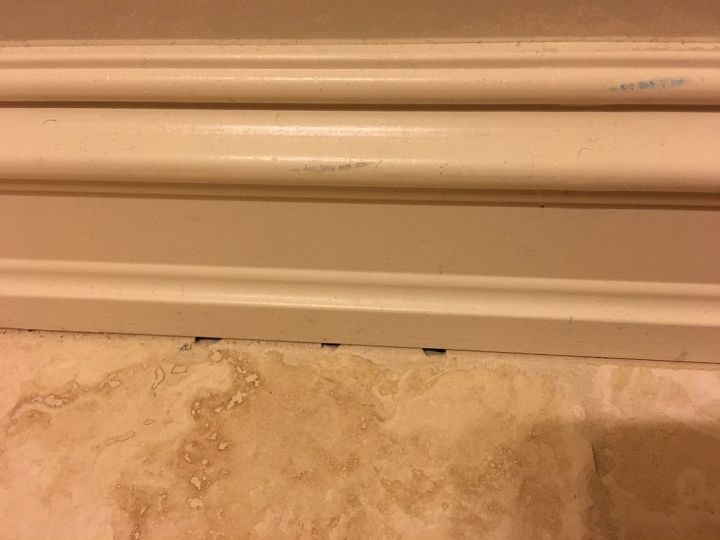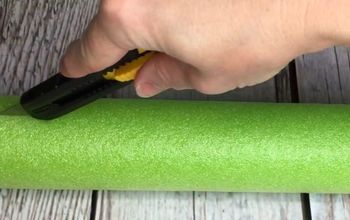DENS BOARD
-
Though I'm not a professional we have installed quite a bit of tile in our home. From that experience I'd say that yes, it is important if this area will be a "wet" area as the side meant for tiling is a moisture barrier. @Miriam, can you think of anyone here that is knowledgeable in tiling to be sure if I'm correct on this?
 Z
on Jun 30, 2013
Helpful Reply
Z
on Jun 30, 2013
Helpful Reply -
-
Rebecca, the board is faced with fiberglass on both sides, so in theory it might be ok. I really can't say for sure, though, and the instructions do call for the gold side to face the studs. I would suggest to follow the manufacturers instruction and redo it. DensArmor is cheap compared to a failed tile job later.
 Hamtil Construction LLC
on Jun 30, 2013
Helpful Reply
Hamtil Construction LLC
on Jun 30, 2013
Helpful Reply -
-
Rebecca, It is best to remove the board and install it as per the directions. Although the inner core is designed to be moisture proof, the gray side is a special acrylic moisture barrier designed to be installed on the "wet-side". Installing the board backwards is similar to wearing a lined raincoat inside-out. I suppose you could leave it the way it is and apply a moisture barrier like "red-guard"...but that isn't cheap and defeats the purpose of using the DenShield Tile Backer board to begin with. Tim
 Hewitt Remodeling Services LLC
on Jul 01, 2013
Helpful Reply
Hewitt Remodeling Services LLC
on Jul 01, 2013
Helpful Reply -
-
Thanks for alerting me @Z Rebbeca, I hope this works out for you. :(
 Miriam Illions
on Jul 01, 2013
Helpful Reply
Miriam Illions
on Jul 01, 2013
Helpful Reply -
-
Rather than "dense Shield" I would go with hardibacker....it is completely water proof..not just resistant...front back inside and outside. Dense shield just has a "water resistant" skin. The core is still gypsum...which if exposed to water will still turn to mush. I have seen small samples of Hardibacker sealed inside a container of water that were many years old...not one single bit of damage.
 KMS Woodworks
on Jul 01, 2013
Helpful Reply
KMS Woodworks
on Jul 01, 2013
Helpful Reply -
-
Thanks guys for your help! We talked to someone at Home Depot who suggested Durock Cement board is the same as Hardibacker. Any thoughts?
 Rebecca Ellis
on Jul 01, 2013
Helpful Reply
Rebecca Ellis
on Jul 01, 2013
Helpful Reply -
-
Thank you @Miriam for alerting the experts. I was pretty sure I was right, but wanted to check with the guys that do this professionally too. Although I have to say my hubby and I do allot of research before we do any project around our home. We always use Hardibacker as @Kevin recommended. For us, nothing else is good enough.
 Z
on Jul 01, 2013
Helpful Reply
Z
on Jul 01, 2013
Helpful Reply -
-
Sorry I was interrupted while writing Rebecca. Durock Cement board is NOT the same as Hardibacker.
 Z
on Jul 01, 2013
Helpful Reply
Z
on Jul 01, 2013
Helpful Reply -
-
Rebecca, As Becky mentioned, hardibacker and cement board (i.e.: durock) are not the same. However, they are both acceptable products used to back tile. As much as I shake my head at times regarding the technical background of some of the help at the big-box stores, perhaps that is what the "someone at HD" meant.
 Hewitt Remodeling Services LLC
on Jul 01, 2013
Helpful Reply
Hewitt Remodeling Services LLC
on Jul 01, 2013
Helpful Reply -
-
Thanks @Hewitt. I guess the best way to see the difference is ask the clerk to show you both. I know all the HoDe stores near us carry both. The cement board is often chippy on the corners which right there tells me it wouldn't be as user friendly as the Hardibacker. It kind of sort of looks like gray MDF.
 Z
on Jul 01, 2013
Helpful Reply
Z
on Jul 01, 2013
Helpful Reply -
-
Durock is a lighter weight version of Wonder Board. Both of those products are fiberglass skinned with a cement type "core". The reason I do not like them for showers is that the core tends to crumble and leave gravel like bits everywhere. Hardibacker cuts much cleaner ( I use a thin blade diamond wheel in a grinder). Hardibacker is like a compressed set of cement with very fine fibers. I have used Wonder board in my cabin under the floor tile..but the reason there was to increase the Thermal mass for the passive Solar design ( wonder board is about 45 pounds per 3 x 5 sheet. There is another product called Rhino Board which is pretty much the same as hardibacker but I have only seen that in 1/4" thick.
 KMS Woodworks
on Jul 02, 2013
Helpful Reply
KMS Woodworks
on Jul 02, 2013
Helpful Reply -
-
Hardibacker is not a good product to use in wet locations imo. When it gets wet or attacked with moisture, it will peel apart like cardboard and absorb mold and mildew. If you place a piece of Hardibacker in a bucket of water for a week, it will break down. Here's a picture of Hardi on a bathroom floor where there was a toilet leak... we tore it out for the homeowner and replaced with Noble Seal TS over the sub floor. A huge piece of subfloor needed replaced around the toilet because of the mold. The Hardi is leaning on the wall and you can see how the mold absorbed into it. As for the shower. Here are some options: *call the manufacturer first. You may be able to cover the board the way it is with Red Guard, Kerdi, Noble Seal etc... *Tear down and start over. Use Durrock or the same board with the right side out.
 Alone Eagle Remodeling, LLC.
on Jul 05, 2013
Alone Eagle Remodeling, LLC.
on Jul 05, 2013
 Helpful Reply
Helpful Reply -
-
The denseboard must be installed according to manufacturer's directions as the surface that accepts the tile is treated with a waterproofing coating. HOWEVER all is not lost. You can fasten a waterproofing membrane over the incorrectly installed material and your back in business. Schluter Kerdi would need to be applied over the surface then tile over that. Just be sure you use the correct thin set material that they suggest. http://www.schluter.com/8_1_kerdi.aspx
 Woodbridge Environmental Tiptophouse.com
on Jul 05, 2013
Helpful Reply
Woodbridge Environmental Tiptophouse.com
on Jul 05, 2013
Helpful Reply -
-
It looks like I'm going to have to agree w/ Woodbridge again (another similar post) on the Schluter system. They have specific seals to go over the tub filler, tub/shower valve and shower head arm. You will need a UN-modified thinset mortar. Nothing with Poly in it. You will use the same thinset to set the wall tile with.
 Houseworks Unlimited, Inc.
on Jul 11, 2013
Helpful Reply
Houseworks Unlimited, Inc.
on Jul 11, 2013
Helpful Reply -
-
Denshield is a waterproof core laminated on each side with a fiberglass based face. It is installed like drywall except you need to run a bead of silicone between the sheets to waterproof the seams. You then need to use fiberglass mesh tape over the seams. It does not require a moisture or vapor barrier behind the sheets. When properly installed Denshield is an adequate tile substrate for shower walls and relatively affordable compared to alternative methods.
 FloorNerd
on Jul 11, 2013
Helpful Reply
FloorNerd
on Jul 11, 2013
Helpful Reply -
-
What you have is densgaurd which the tile goes on gray side of the board!!! Yes reverse the board.
 FloorNerd
on Jul 11, 2013
Helpful Reply
FloorNerd
on Jul 11, 2013
Helpful Reply -
-
You do not need to use kerdi on either the dens guard or shield as both are pretty much water proof to a certain % they both are not recommend in steam showers.
 FloorNerd
on Jul 11, 2013
Helpful Reply
FloorNerd
on Jul 11, 2013
Helpful Reply -
-
You don't need to put kerdi over either board type as there waterproof to a certain %. They are not recommend for steam showers and floors.
 FloorNerd
on Jul 11, 2013
Helpful Reply
FloorNerd
on Jul 11, 2013
Helpful Reply -
-
Mark the densguard is water resistant. Not water proof. You need to use a water proofing membrane with that product. The joints will need to be sealed as does the fasteners.
 Woodbridge Environmental Tiptophouse.com
on Jul 11, 2013
Helpful Reply
Woodbridge Environmental Tiptophouse.com
on Jul 11, 2013
Helpful Reply -
-
Thanks Woodbridge, there are a number of these Boards that I think all do different things. I've used densshield once with no issues and both sides are laminated fiberglass which to my knowledge is water proof or resistant but not from steam. I guess the best way is to redguard or hydroban these products regardless for extra insurance.
 FloorNerd
on Jul 12, 2013
Helpful Reply
FloorNerd
on Jul 12, 2013
Helpful Reply -
-
My thoughts are the seams are not moisture resistant. Thus the need to add that additional layer of protection. While the boards themselves are, as soon as you put a screw into them you break the seal. I used the dens armor plus in all my baths I do. and I use the membrane before I tile on the walls. Never had a call back. I have not used a cement board in years.
 Woodbridge Environmental Tiptophouse.com
on Jul 12, 2013
Helpful Reply
Woodbridge Environmental Tiptophouse.com
on Jul 12, 2013
Helpful Reply -
Related Discussions
How to get rid of mice?
We seem to have some unwelcome Mickeys and Minnies in our house. What is the best way to get rid of them?
How to remove popcorn ceiling with asbestos?
I want to remove my popcorn ceiling, but it has asbestos in it. How do I go about this safely?
How to caulk baseboard gaps?
How do I fill gaps at baseboard, should I caulk? If so, does anyone know how to caulk baseboards?
How to fix squeaky hardwood floors?
How do I fix squeaky hardwood floors?
Water damage on bathroom ceiling
I am about to patch up this water damage on a low bathroom ceiling. What can i paint/seal the entire ceiling with to minimize future water damage? the ceiling is very... See more
Brown paper floor/wall help
I have purchased a brown roll of paper because I wanted a consistent "vein" look through out the walls and the brown paper bags I was getting would sometimes be "vein... See more






